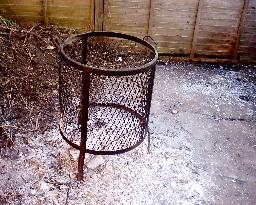Two recipes and I can't decide which one to try:
Vegetarian Stuffed Peppers
Serves 4
- 4 large green peppers
- 1 medium onion, chopped
- 2 cloves of garlic, crushed
- 4 ozs (112g) long-grain rice, cooked
- 8 ozs (225g) tomatoes, chopped
- 2 sprigs of parsley, chopped finely
- 4 ozs cheddar cheese, grated
- 2 ozs (56g) butter
- 1 tablespoon olive oil
- Salt and pepper
Method
- Cut a slice off the top of each pepper, remove centre core and seeds.
- Brush each pepper on the outside with the olive oil and then stand the peppers upright in an ovenproof dish.
- Melt the butter in a saucepan and fry the chopped onion gently. Add the tomatoes, rice, parsley, crushed garlic, salt and pepper and combine.
- Pile the mixture into the pepper shells.
- Top each pepper with grated cheese.
- Bake for 30-40 minutes in a pre-heated oven at Gas Mark 4 (350°F/180°C) until the peppers are tender. Serve hot.
Note: Chopped mushrooms can replace some of the tomatoes in the mixture
Bacon Stuffed Peppers
Serves 6
6 small-medium red peppers
- 200g (7oz) streaky bacon, chopped
- 1 onion, peeled and chopped
- Knob of butter
- 30g (1oz) breadcrumbs
- 2 hard-boiled eggs, shelled and chopped
- 45g (1½oz) finely grated Cheddar cheese
- Salt and freshly ground black pepper
- To make the filling: Put the bacon, onion and butter in a frying pan and cook gently for about 10 mins, until onion is tender. Take off heat and stir in breadcrumbs, chopped egg, half the cheese and some seasoning.
- Set the oven to 180°C/Gas Mark 4.
- Cut tops off peppers and pull out the cores and seeds. Rinse them well. Slice a little off bottom of peppers, if necessary, so that they stand up straight.
- Spoon the filling into the peppers and sprinkle with the rest of the cheese. Stand them in a roasting tin, cover loosely with foil and bake for 45 mins. Remove the foil and cook for another 10 mins, to brown the tops. Serve hot with peas, or cold with salad.








